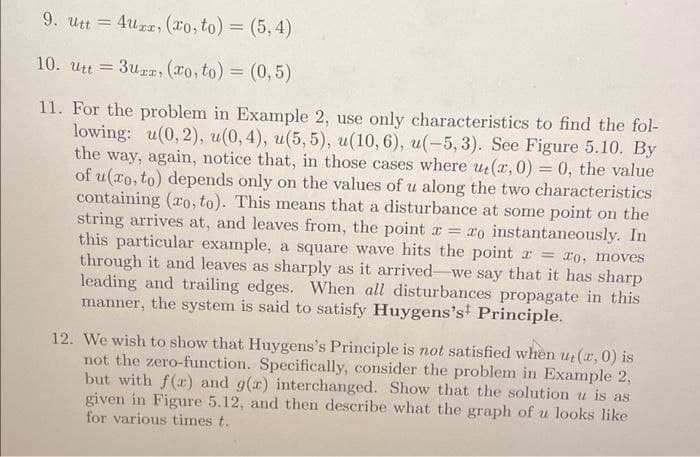9. Ut = 4uxx, (xo, to) = (5,4)
Advanced Engineering Mathematics
10th Edition
ISBN:9780470458365
Author:Erwin Kreyszig
Publisher:Erwin Kreyszig
Chapter2: Second-order Linear Odes
Section: Chapter Questions
Problem 1RQ
Related questions
Question
Hand written..partial differential..solve only Ques. 9

Transcribed Image Text:9. Utt = 4uxx, (xo, to) = (5,4)
10. Utt = 3Uzz, (xo, to) = (0,5)
11. For the problem in Example 2, use only characteristics to find the fol-
lowing: u(0,2), u(0,4), u(5,5), u(10, 6), u(-5, 3). See Figure 5.10. By
the way, again, notice that, in those cases where ut(x, 0) = 0, the value
of u(xo, to) depends only on the values of u along the two characteristics
containing (zo, to). This means that a disturbance at some point on the
string arrives at, and leaves from, the point x = xo instantaneously. In
this particular example, a square wave hits the point x =
through it and leaves as sharply as it arrived we say that it has sharp
leading and trailing edges. When all disturbances propagate in this
manner, the system is said to satisfy Huygens's Principle.
xo, moves
12. We wish to show that Huygens's Principle is not satisfied when u, (x, 0) is
not the zero-function. Specifically, consider the problem in Example 2,
but with f(r) and g(x) interchanged. Show that the solution u is as
given in Figure 5.12, and then describe what the graph of u looks like
for various times t.
Expert Solution
This question has been solved!
Explore an expertly crafted, step-by-step solution for a thorough understanding of key concepts.
This is a popular solution!
Trending now
This is a popular solution!
Step by step
Solved in 2 steps with 2 images

Recommended textbooks for you

Advanced Engineering Mathematics
Advanced Math
ISBN:
9780470458365
Author:
Erwin Kreyszig
Publisher:
Wiley, John & Sons, Incorporated

Numerical Methods for Engineers
Advanced Math
ISBN:
9780073397924
Author:
Steven C. Chapra Dr., Raymond P. Canale
Publisher:
McGraw-Hill Education

Introductory Mathematics for Engineering Applicat…
Advanced Math
ISBN:
9781118141809
Author:
Nathan Klingbeil
Publisher:
WILEY

Advanced Engineering Mathematics
Advanced Math
ISBN:
9780470458365
Author:
Erwin Kreyszig
Publisher:
Wiley, John & Sons, Incorporated

Numerical Methods for Engineers
Advanced Math
ISBN:
9780073397924
Author:
Steven C. Chapra Dr., Raymond P. Canale
Publisher:
McGraw-Hill Education

Introductory Mathematics for Engineering Applicat…
Advanced Math
ISBN:
9781118141809
Author:
Nathan Klingbeil
Publisher:
WILEY

Mathematics For Machine Technology
Advanced Math
ISBN:
9781337798310
Author:
Peterson, John.
Publisher:
Cengage Learning,

